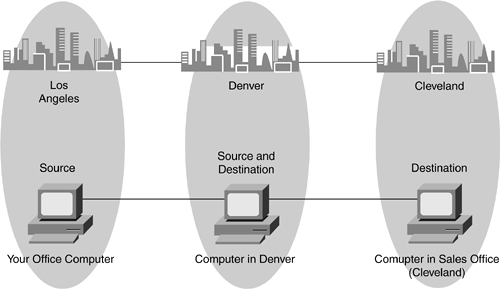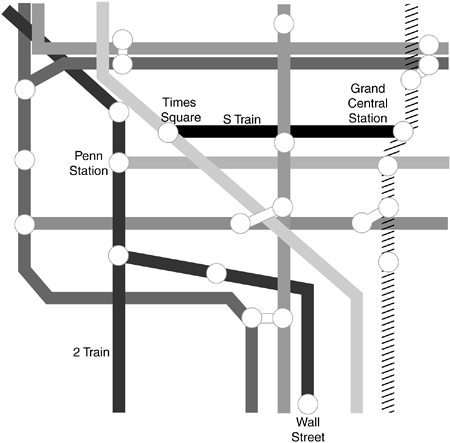What Is a Network?
A network is a system of interconnecting lines, such as telephone lines for communication or subway tracks for transportation. We use transportation networks during the course of an average day for a number of different purposes: the train or subway for daily expeditions, the roads for commuting to and from work, and the airlines for longer trips. In the computer and Information Technology (IT) environment, a network is just defined as a group of computers and connecting circuitry functioning in a specific manner. A transportation network is defined as a system of crossing or interconnecting routes, such as roads or subway tracks. This chapter analogizes transportation systems and computer systems to help you apply computer concepts to a familiar context.
Transportation and Computer Networks
Let's look at these definitions in more detail. Simply stated, a transportation network connects two or more points, enabling the exchange of resources, such as people, goods, or information. These points might be cities connected by railroad lines, buildings within a city connected by streets, or desks within a building connected by hallways and stairwells. The common denominator here is that there is some sort of connection, or path, between these points?railroad tracks, city streets, or office hallways. These paths provide a way for people or goods to get from one point to another. This originating point, or starting point, is called the sender, originator, or source; the second point, or arrival point, is called the receiver, or destination.
In transportation networks, an originating (source) and ending point (destination) are two distinct locations in a journey. In addition, the ending point can become the originating point for another part of a journey. Think of a flight from Los Angeles to Cleveland with a two-hour layover in Denver, as shown in Figure 1-1. Denver, in this case, is both a destination and an end point of one trip and the starting point of another trip. Computer networks function in a similar way. Data can be sent to a destination (endpoint) that in turn becomes the originating point for another transmission to the final destination. These sources and destinations are not fixed points, but change depending on the direction of message (data) flow.
Figure 1-1. Source and Destination Relationships

To better understand IT networks, such as data (computer or Internet) or voice (telephone) networks, and the concept of switching within these networks, let's look first at the networks we use daily, such as the subway, railroad, and airline routes. As described previously, these are transportation networks that effect the moving of resources (people) from one point to another across an established path. Take, for example, the New York City subway. Figure 1-2 shows a few stops.
Figure 1-2. New York City Subway Stops

If you are on Wall Street and want to go to Grand Central Station, you cannot take a direct route between these two points. As illustrated in Figure 1-2, you might take the number 2 train to Times Square and the S train from Times Square to Grand Central.
It is the connection of Wall Street to Times Square to Grand Central that enables you to move from Wall Street to Grand Central, and it is the network of these subway connections that enables you to move throughout the city.
The airline and the subway networks connect different points and connect them in differing fashions. In the case of the airlines, cities are connected via preplanned routes in the sky. In the case of the subway, various city points (stations) are connected via subway tracks. A key point here is that just because a network path passes through a city block, in the case of the subway, or over a city, in the case of an airline, that pass-through point cannot be used to get on or off the network. The only way you can join a network is at an origination (starting) or termination (ending) point of the network connection.
While walking along the streets of New York City, for example, you can hear, and sometimes see, the subway trains running under the city sidewalk, but you can't get on the train from that point (unless you happen to be in a Hollywood movie chase scene). To get on that train, you must get to a station on that train's route, a demarcation point. A demarcation point is the boundary between two entities; in this case, the demarcation point is the boundary between the street and the train station. This demarcation point is both the point whereby passengers get on the train (originating or source point) or get off the train (terminating or destination point).
It is important to understand that the origination point and the termination point are interconnected, meaning they are connected to each other in some fashion. In the New York City subway, Wall Street and Times Square are interconnected via one set of tracks, Times Square and Grand Central Station are interconnected via another set of tracks, and Wall Street and Grand Central Station are interconnected via yet another set of tracks. Times Square is the switching point for passengers between Wall Street and Grand Central, because subway passengers need to disembark the number 2 train (Wall Street?Times Square) in order to board the S train (Times Square?Grand Central).
Each track segment and station is a leg in the subway network. Legs of the network are joined at key locations, where other major arteries carry you to other key locations. These key locations are "distribution" or "hub" points on the network. This is true of airlines, roads, and telephone calls.






